Executive summary
The current report gives a glimpse of the EU-Korea Cultural Festival, in other words, it is a cultural diplomacy project that was formulated to enhance relations between the European Union and South Korea. “Bridging Cultures” is a concept for an EU-Korea Cultural Festival and it was designed to place the EU in the South Korean people’s focus as more than a trading partner. The identified key concerns include the need to address various stakeholders, build a favourable EU image, and include sustainable development objectives.
Some of key’s areas of concern involved in the project were the identification of institutions to work with and the enhancement of effective management of events. Lastly, the key communication and collaboration plan was set up to align with local gains as well as recognizing cultural differences hence fitting perfectly in the EU strategic direction for international relations. As such, not only does the inclusion of the UN Sustainable Development Goals in the programming of the festival stress on education and sustainable community development, but also results in increasing the cultural presence and perception of the EU in South Korea.
1. Introduction
In the world today, cultural diplomacy valuable relationship and understanding culture has become an effective way of establishing international relations. As for the EU-Korea Cultural Festival, ‘Bridging Cultures’ is another form of diplomatic strategy which is supposed to increase the EU presence and recognition in South Korea through the celebration of mutual cultural exchange. The EU values include diversity, inclusion, and cooperation that will all be represented through this festival using medium like’s music, art, and food.
The aim of this research is to design an overall project proposal for the festival, which will correspond to the general goals of EU diplomacy as well as to other worldwide initiatives. This project will address several key areas: the purpose, principles, roles and goals of the festival as well as how it contributes to the promotion of EU values and long-term partnership; analysis of the stakeholders and their activation and engagement mapping; plan of actions and budget and time frame to assess the implementation of the festival. These elements are culture, sustainability, entertainment, local communities, environment, South Korea and people with disabilities by combining all these elements the festival seeks to foster these lasting key areas.
Top UK Assignment Samples
2. Project Overview
2.1 Objective
The idea of EU-Korea bridging cultures is the establishment supports cultural interaction that enhance and make diplomatic relations between EU and South Korea stronger.

Figure 1: Project Objectives
(Source: Self-Created)
Promoting EU Values through Cultural Engagement:
Essentially, the message of the festival which will present the EU in music, art and food will be the values which the EU as the world’s leading power supporting democracy, human rights and tolerance to the cultures stands for.
Enhancing EU Visibility in South Korea:
Another objective is to familiarise the South Korean audiences and spectators with the EU and its member states. This is will be done through a series of selected events that will be tailored to capture the publics’ attention as well as their participation.
Encouraging Cross-Cultural Collaboration:
According to its objectives, it is aimed at encouraging the emergence of sustainable partnerships between European and South Korean institutions. The project is thankful for cultural and education twins, the project will have an opportunity to continue its work in other fields with areas of concentration such as art and culture, education dialogue and sustainable city cooperation.
2.2 Expected Outcomes
The festival is expected to deliver several key outcomes. The following are some of the expected outcomes of the strategic festival:
Increased Awareness of EU Culture and Values: A pre-and post-festival survey among South Koreans will reveal 25 per cent uplift in consciousness and admiration of the EU values and tradition.
Development of Long-Term Partnerships: EU and South Korean institutions will create major strategic partnerships over the next years to foster cultural and educational endeavours.
Promotion of Sustainability and Education: The festival will take the SDG into the program as a focal point of works and speeches such as the workshops and debates concerned with the themes of sustainability and education.
2.3 Rationale
“Bridging Cultures” – EU-Korea Cultural Festival is a cultural diplomacy project of the European Union in South Korea to popularise the EU presence in South Korea. This believes is line with the EU’s strategic objectives of advancing soft power, where diversity, inclusion and cooperation as EU values demonstrated through the music, art and food at the festival (Novotná et al. 2023). South Korea is said to be one of the cultural hot-beds in the eastern part of the world; thus, it can act as a suitable environment for this interaction (Yoon and Zamorano, 2023). The festival aligns with UN Sustainable Development Goals in the following ways; Quality Education (SDG 4), Sustainable Communities (SDG 11) as well Partnerships (SDG17) (CAI and Choi, 2020). Moreover, it will help people to make Europe better understood, increase the presence of EU culture and establish meaningful cooperation.
3. Insight on Stakeholders and communication strategy
3.1 Overview of key stakeholders
The success of the EU-Korea Cultural Festival: Therefore, the engagements of Bridging Cultures are based on the participation of the various stakeholders. Key stakeholders include
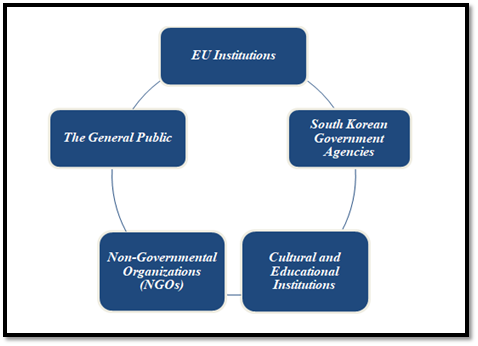
Figure 2: Overview of key stakeholders
(Source: Self-Created)
EU Institutions: The core institutions include the European External Action Service, which will be responsible for coordinating the festival to meet EU diplomatic goals and the EU Delegation to the Republic of Korea (Ashrafi et al., 2020).
South Korean Government Agencies: Governmental support will be provided by the Ministry of Culture, Sports and Tourism which will be in charge of the organisational matters such as the selection of the venues, obtaining of the permits, and promotion of the festival in the region (Ashrafi et al., 2020).
Cultural and Educational Institutions: Festival content will be supported by local South Korean universities as well as other European cultural institutes namely Goethe-Institute, and Institute Français.
Non-Governmental Organizations (NGOs): A few such players include the Korea Foundation for International Cultural Exchange (KOFICE) which will assist in organizing the fiesta areas as sustainability and community involvement (Ashrafi et al., 2020).
The General Public: The target audience of the festival is the people of South Korea mainly the youth and students who are inclined towards inter-cultural relations and education.
Top UK Assignment Cities
3.2 Consortium Formation
This festival is to be implemented through cooperation with several partner institutions to make sure it draws on both European and South Korean experiences. The consortium will include:
Goethe-Institut Seoul: According to the organizer of art and music workshops, Goethe-Institut will have experience in cultural exchange and cooperation.
Korea Foundation for International Cultural Exchange (KOFICE): It is with this key local partner that most of the logistics of the festival will be coordinated including relations with the stakeholders and other Korean cultural activities.
Institut Français: All the culinary aspects of the festival will be managed by the French Cultural Institute to promote European culinary variety in the form of activities and information displays.
3.3 Communication Strategy
EU-Korea Cultural Festival’s communication strategy aims to ensure that the festival attracts as many people as possible and is understood by as many people accordingly. Key components include:
Digital Outreach: Some of the most successful marketing techniques include using popular social media sites like Instagram, youtube, and Naver sites especially to the youth.
Media Engagement: Negotiation with the South Korean newspapers, magazines and with the televisions networks to have adequate coverage (Maon et al., 2021). Media will be employed in form of press releases and interviews to create awareness.
Event-Based Communication: From the above discussion, the following should be understood clearly: Use the events of the festival as communication tools (Maon et al., 2021). Performances, workshops, and panel discussions to be broadcasted on EU’s social media pages allow the audience to witness experiences.
Influencer Collaboration: Invite well-known South Korean influencers to increase the festival’s popularity. Social media week will be advertised through people by sharing stories from people who attended the event.
4. Project Budget, Timeline, and Quality Standards
4.1 Budget Breakdown
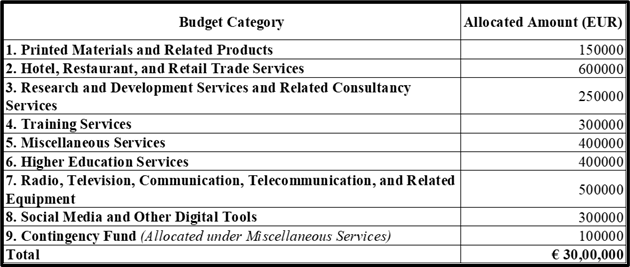
Table 1: Budget Breakdown
(Source: Self-created)
The budget for the EU-Korea Cultural Festival is allocated as follows: €150,000 for printed materials & related products; €600,000 for hotel, restaurant & retail trade services. The amount of €250,000 has been allocated for research and development services & consultancy; €300,000 for training services; €400,000 for miscellaneous services and €400,000 for higher education services.
4.2 Timeline and Milestones
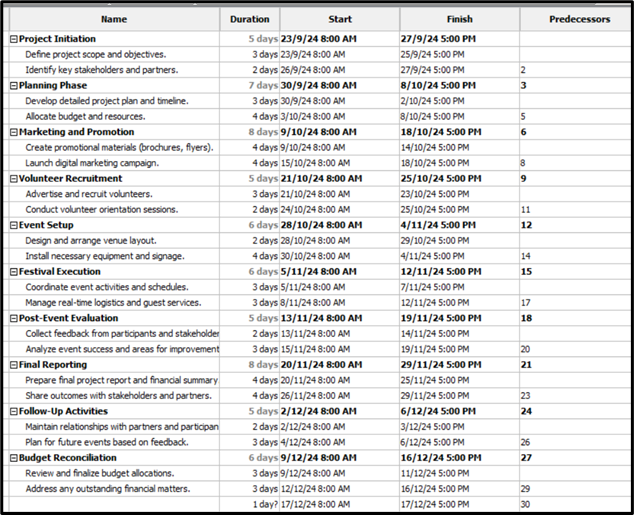
Figure 3: Work Breakdown Structure
(Source: Created by using ProjectLibre)
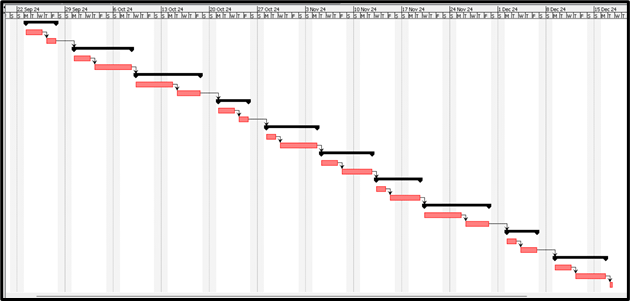
Figure 4: Project Plan
(Source: Created by using ProjectLibre)
Tasks of “Bridging Cultures” involve identifying project objectives, identifying the locations, creating the publicity materials, forging partnerships, creating the festival calendar, coordinating the event and arranging for the volunteers as well as managing the specific event (Refer to Figures 3 and 4). The follow-up activities include capturing comments, writing reports and closing the financial account for the event, thus keeping proper assessment and planning for future projects in check.
The project schedule for the “EU-Korea Cultural Festival: In “Bridging Cultures” starting September 23, 2024, activities are enumerated, correlated with timeframes and assigned to specific individuals. It comprises project initiation meetings, partner identification and consolidation, promotional and marketing material production, training curriculum development, event organisation and implementation, festival delivery and monitoring and evaluation documentation.
4.3 Quality Standards
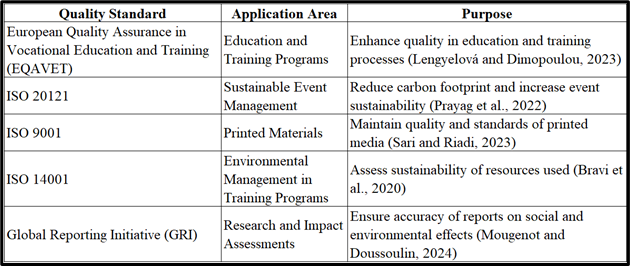
Figure 5: Quality Standards
(Source: Self-created)
Maintaining quality standards of the events includes the above application areas and the purpose of the study. Bridging Cultures event is imperative that quality standards have been developed and are followed to ensure the success of the EU-Korea Cultural Festival. The project will also meet other European Union standards in project management such as European Quality Assurance in Vocational Education and Training (EQAVET) which focuses on the systematic approach towards enhancement of quality in education and training (Lengyelová and Dimopoulou, 2023). The project will stick to the best practices in sustainable event management that include standards such as ISO 20121, which addresses aspects of decreasing the carbon footprint and increasing the sustainability of events (Prayag et al., 2022).
Quality assurance measures will be applied to major outputs for which it will be necessary to maintain high levels of quality. ISO 9001 shall hence be implemented for printed media in order to keep a check on the quality and standard of the material (Sari and Riadi, 2023). Resources that are used and the requirements for their usage will be in conformity with the ISO 14001 environmental management to assess the sustainability of the training program (Bravi et al., 2020). The accuracy of research and impact assessments are regulated by some protocols such as the Global Reporting Initiative (GRI) which offers a checklist for the reports of organisations on social and environmental effects (Mougenot and Doussoulin, 2024). These measures for quality assurance will improve accountability, and stakeholder trust as well as enable the successful accomplishment of the set goals for the project.
4.4 Control Measures
Monitoring and control will be done in the form of reporting, which will be done monthly or quarterly, depending on the needs of the EU authorities and project stakeholders. Metrics for measuring performance will include the number of people attending the event, the partnerships they reach out in order to set with, and the feedback that is received from the followers through questionnaires. The project will in particular address at least three of the United Nations sustainable development goals (SDGs) (Refer to Appendix 1). In the case of quality education, the number and participation levels in educational workshops will be used to determine the level of success achieved in attaining the SDG (Saini et al., 2023). Gender Equality (SDG 5) will be measured based on the gender diversity ratio of the attendees and stakeholders (Zampone et al., 2024). SDG 10 which Reduced Inequalities includes the exclusion of minorities and other vulnerable groups will be assessed by the uptake taken by such groups and their satisfaction status (Cojocaru et al., 2022). Applying this highly structured and categorised approach will serve the purpose of providing accountability and compliance to the project’s goals and what is foreseen by the EU.
5. Risk Analysis and Mitigation
5.1 Potential Risks

Figure 5: Risk Register
(Source: Created by using ProjectLibre)
1. Financial Risks: They include the problem of budget distortions or failure that may lead to the development of the project. If the company fails to stick to the estimated EUR 3,000,000 budget, then the project might face funding deficits which means that the size of the project will be reduced, or the project may be stopped completely (Refer to Figure 5).
2. Operational Risks: Any social factors that affect the schedule of project execution, for example getting venues or seeking permission to conduct an activity may slow down the process. Such delays might affect the stakeholders’ participation and downgrade the role of the project with regard to raising the EU profile (Katirtzidou et al., 2023).
3. Stakeholder Engagement Risks: Neglecting important stakeholders including the local people or failing to influence stakeholders affects the level of success of the project. Non-participation may create a wrong perception of the EU thus eradicating the intended thought behind the initiative (Kujala et al., 2022).
4. Compliance Risks: Failure to adhere to EU regulations or to meet the eligibility requirements of the tender can lead to writing off the bid. The following risk threatens project approval and its funding critically.
5. Cultural Sensitivity Risks: Lack of cultural sensitivity or awareness of Korean culture might hence result in poor communication and poor reception of the project. It is such cultural sensitivity that can be detrimental to the success of the project in addition to its reputation.
Get Assignment Help for Top Subjects
5.2 Mitigation Strategies
1. Financial Management
A good financial management system should be adopted to ensure that the expenditures are controlled and follow the budgets (Nurgaliyeva et al., 2022). Financial checks and prologues will be done before a certain project to find out any over expenditures.
2. Project Timeline Management
Establishment of a detailed project calendar together with milestones to ensure proper tracking of the course of the project will help in this respect (Sankaran et al., 2021). Daily progress meetings involving all teams will thus enable one to assess the likelihood of delays and adapt the schedule as necessary.
3. Stakeholder Engagement Initiatives
The main reason for incorporating frequent two-way communication with stakeholders is that such a move will increase their support and participation (Satizábal et al., 2022). Another aspect of risk management concerns stakeholders’ engagement; nurturing great relations with local communities will help to address possible problems in future.
4. Compliance Checks
Adequate compliance shall be conducted at different project phases and times thus ensuring compliance with all the regulations and criteria set (Anderljung et al., 2023). It will be the responsibility of the team members to make sure that they conduct training sessions for everyone so that everyone is up to date with the legal matters of the company.
5. Cultural Sensitivity Training
Education on cultural diversity should be undertaken with all the team members including the communication people, to avoid being associated with rude gestures during their occasions.
6. Conclusion and Recommendations
The project “Bridging Cultures” is a good chance to improve the EU and South Korea’s cultural diplomacy. The EU-Korea Cultural Festival project is a great way of increasing the EU’s profile in South Korea through the promotion of culture which is an essential aspect of the society. The project generates the desire in the minds of the EU’s diverse stakeholders to perceive the EU in a positive way and meet the needs of the local citizens through the integration of sustainable development goals. The event also acts as a cultural mediator, thus supporting the EU’s key fostering of international relations’ goals and objectives. In achieving this goal of encouraging unity and improved relations between these areas, the festival showcases EU values of diversity, inclusion and collaboration through means of arts. Beneficial products for the E.U. and South Korea and their stakeholders include; increased knowledge among South Koreans regarding the culture of the EU, formation of enduring cooperation, and increased sustainability based on the United Nations Sustainable Development Goals.
According to the findings of the study, the organisers shall ensure that stakeholders are engaged and ample communication techniques are employed. The process involves consultation with the local communities, educational institutions and local cultural organisations in order to increase locals’ buy-in into the whole process. Moreover, the use of social media, and influencer marketing will provide a way for the targeted youth audience, which is very important for the festival. Due to quality control that has already been set and predetermined at each phase of the project, regular assessments and subsequent tracking of the observations made at the time will allow for the correction of deviations in project implementation from the norms of successful eco-event management. Following these recommendations, the EU-Korea Cultural Festival may become a blueprint for subsequent cultural diplomacy that will yield tangible dividends to both sides.
Reference List
Anderljung, M., Barnhart, J., Korinek, A., Leung, J., O’Keefe, C., Whittlestone, J., Avin, S., Brundage, M., Bullock, J., Cass-Beggs, D. and Chang, B., (2023) ‘Frontier AI regulation: Managing emerging risks to public safety’, arXiv preprint arXiv:2307.03718.
Ashrafi, M., Walker, T.R., Magnan, G.M., Adams, M. and Acciaro, M., (2020). ‘A review of corporate sustainability drivers in maritime ports: a multi-stakeholder perspective.’ Maritime Policy & Management, 47(8), pp.1027-1044.
Bravi, L., Santos, G., Pagano, A. and Murmura, F., (2020) ‘Environmental management system according to ISO 14001: 2015 as a driver to sustainable development’, Corporate Social Responsibility and Environmental Management, 27(6), pp.2599-2614.
Cai, Y.J. and Choi, T.M., (2020). ‘A United Nations’ Sustainable Development Goals perspective for sustainable textile and apparel supply chain management.’ Transportation Research Part E: Logistics and Transportation Review, 141, p.102010.
Cojocaru, T.M., Ionescu, G.H., Firoiu, D., Cismaș, L.M., Oțil, M.D. and Toma, O., (2022) ‘Reducing inequalities within and among EU Countries—assessing the achievement of the 2030 agenda for sustainable development targets (SDG 10)’, Sustainability, 14(13), p.7706.
Katirtzidou, M., Skoulikaris, C., Makris, C., Baltikas, V., Latinopoulos, D. and Krestenitis, Y., (2023) ‘Modelling stakeholders’ perceptions in participatory multi-risk assessment on a deltaic environment under climate change conditions’, Environmental Modeling & Assessment, 28(3), pp.367-388.
Kujala, J., Sachs, S., Leinonen, H., Heikkinen, A. and Laude, D., (2022) ‘Stakeholder engagement: Past, present, and future’, Business & Society, 61(5), pp.1136-1196.
Lengyelová, K. and Dimopoulou, N., (2023) ‘Benchmarking of the e-Learning Quality Assurance in Vocational Education and Training: Project Results’, Quality Innovation Prosperity, 27(2), pp.1-15.
Maon, F., Swaen, V. and De Roeck, K., (2021). ‘Corporate branding and corporate social responsibility: Toward a multi-stakeholder interpretive perspective.’ Journal of Business Research, 126, pp.64-77.
Mougenot, B. and Doussoulin, J.P., (2024) ‘A bibliometric analysis of the Global Reporting Initiative (GRI): global trends in developed and developing countries’, Environment, Development and Sustainability, 26(3), pp.6543-6560.
Novotná, T., Christiansen, T. and Lee, M., (2023). ‘EU-Korea relations at 60: managing cooperation in the context of great power rivalry.’ Asia Europe Journal, 21(4), pp.481-492.
Nurgaliyeva, A., Ismailova, D. and Sarybayeva, I., (2022) ‘Regarding the prospects for the introduction of the budgeting system of international financial organisations of the future’, Futurity Economics Law, 2(3), pp.38-50.
Prayag, G., Chowdhury, M., Prajogo, D., Mariani, M. and Guizzardi, A., (2022) ‘Residents’ perceptions of environmental certification, environmental impacts and support for the world expo 2015: The moderating effect of place attachment’, International Journal of Contemporary Hospitality Management, 34(3), pp.1204-1224.
Saini, M., Sengupta, E., Singh, M., Singh, H. and Singh, J., (2023) ‘Sustainable Development Goal for Quality Education (SDG 4): A study on SDG 4 to extract the pattern of association among the indicators of SDG 4 employing a genetic algorithm’, Education and Information Technologies, 28(2), pp.2031-2069.
Sankaran, S., Jacobsson, M. and Blomquist, T., (2021) ‘The history and future of projects as a transition innovation: Towards a sustainable project management framework’, Systems research and behavioural science, 38(5), pp.696-714.
Sari, R.R.K. and Riadi, S., (2023) ‘ISO 9001-2015: Compliance Audit of Quality Control Product Procedures’, Jurnal Bisnis Mahasiswa, 3(3), pp.248-261.
Satizábal, P., Cornes, I., Zurita, M.D.L.M. and Cook, B.R., (2022) ‘The power of connection: Navigating the constraints of community engagement for disaster risk reduction’, International Journal of Disaster Risk Reduction, 68, p.102699.
Yoon, S.W. and Zamorano, M.M., (2023). ‘EU-South Korea international cultural relations in the twenty-first century: an overview.’Asia Europe Journal, 21(4), pp.565-585.
Zampone, G., Nicolò, G., Sannino, G. and De Iorio, S., (2024) ‘Gender diversity and SDG disclosure: the mediating role of the sustainability committee’, Journal of Applied Accounting Research, 25(1), pp.171-193.
Dissertation - Digi Assignment Help
-
How to Analyze Data for a Macroeconomics Dissertation ?by Amelia on May 6, 2025
Macroeconomics is a branch of economics that deals with the performance, structure, behaviour, and decision-making of an economy as a whole. Through Macroeconomics analysis, you will learn about interest rates, inflation, growth, employment, politics, and… The post How to Analyze Data for a Macroeconomics Dissertation ? first appeared on Digi Assignment Help.
-
How to Write an Accounting Dissertation: A Guide for UK Studentsby Amelia on February 19, 2025
UK students who do research in accounting should always update themselves with the current happenings, current issues, and modern aspects of the particular issue. Universities throughout the globe are competing to develop their research profile… The post How to Write an Accounting Dissertation: A Guide for UK Students first appeared on Digi Assignment Help.
-
How to Write a Dissertation on Patient-Centered Careby Amelia on February 7, 2025
Patient-centered care is a nuanced topic that has a great impact on healthcare. It primarily involves prioritising a patient’s requirements, preferences, and values. Writing a dissertation is a milestone in your academic journey, and writing… The post How to Write a Dissertation on Patient-Centered Care first appeared on Digi Assignment Help.
-
How to Structure a First-Class Dissertation: A Guide for UK Studentsby Amelia on February 6, 2025
Dissertations are worth so much, if you’re in your final year of the UK University, it’s worth a good chunk. Sometimes even 50, something even 100 of your final year mark. So, it is really… The post How to Structure a First-Class Dissertation: A Guide for UK Students first appeared on Digi Assignment Help.
-
Tips for Writing a Compelling Dissertation Abstractby Amelia on February 4, 2025
Why Abstract Matters? Abstract matters because it’s the first thing, or one of the first things, that somebody reading your thesis is going to see. Who is going to be reading your thesis, it’s your… The post Tips for Writing a Compelling Dissertation Abstract first appeared on Digi Assignment Help.
-
Dissertation Structure and Formatting Guidelines for UK Studentsby Amelia on January 10, 2025
The structure and format of a dissertation are critical for presenting your research or thesis in a well-organized and professional manner, enhancing its academic value and effectively showcasing your contributions to the field. Title Page… The post Dissertation Structure and Formatting Guidelines for UK Students first appeared on Digi Assignment Help.